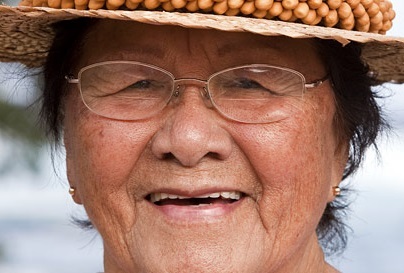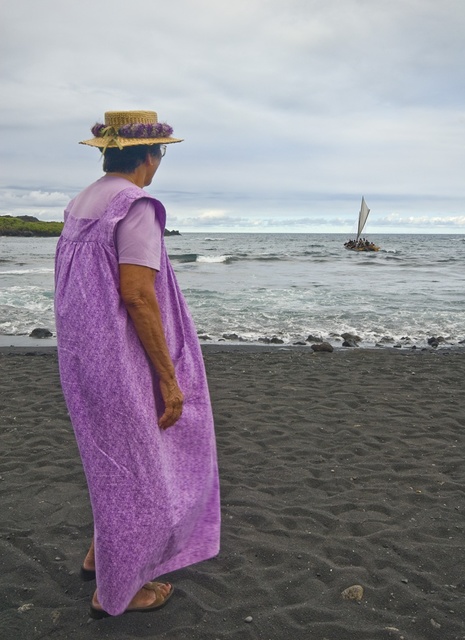HILO — Hawaiian cultural practitioner, preservationist and educator, revered kupuna, licensed practical nurse — Winifred Pele Hanoa was a force of nature, not unlike her namesake volcano goddess. ADVERTISING HILO — Hawaiian cultural practitioner, preservationist and educator, revered kupuna, licensed
HILO — Hawaiian cultural practitioner, preservationist and educator, revered kupuna, licensed practical nurse — Winifred Pele Hanoa was a force of nature, not unlike her namesake volcano goddess.
Those who knew and loved “Aunty Pele,” who was 92 when she died April 6 in Waiohinu, said that in a lifetime of community service marked with awards and achievements, her greatest was keeping Ka‘u, Ka‘u.
“She was the one who gave us the insights of what it meant to be a Native Hawaiian in today’s world but still practicing the old culture,” said Lehua Lopez, a board member for Pele Defense Fund, which fought against geothermal development in the 1980s and the state’s Ka‘u Forest Reserve Management Plan this decade. “It was her example of ku‘e, standing firm, that has given us the courage and strength to resist the changes that would destroy the places that have now become most precious to all of us, native and non-native.”
Hanoa was co-founder, with her daughter, Keolalani Hanoa, of the Punalu‘u Preservation, which became Ka‘u Preservation. The organization was dedicated to keeping Ka‘u, the state’s largest district and home to the largest wilderness area and longest undeveloped coastline, a protected resource and “living classroom.”
Hanoa, who became president of the group after her daughter died in 2006, helped spearhead efforts thwarting large-scale development proposals in in Ka‘u from 1980s on, including a spaceport, the five-hotel Hawaiian Riviera Resort, a 2,300-bed prison — and a later revival of the semi-abandoned Sea Mountain at Punaluu Resort, featuring 1,500 to 2,000 housing units.
“If the developer gets his way, we will have to find a new place to teach the children,” Hanoa said in 2006. “They say they plan to build away from the beach. But where are they going to put 1,800 houses? A shopping center? A hotel?”
“She grew up in a very special place at Punalu‘u beach, and it was the lifestyle back then,” said Elsa Dedman, Hanoa’s daughter. “Throughout mom’s life and career, it was about preservation because what she had as a child was so special to her, and to all of us, Keola, as well. Growing up in Ka‘u, the lifestyle and culture was special, and I think that is basically is what makes my mom special — where she came from, the aina, the history, the culture, the Pele lineage.”
Filmmaker Danny Miller featured Hanoa in a series of documentaries, including “Saving Ka‘u’s Coast,” which he co-produced with Julia Neal, editor and publisher of The Ka‘u Calendar monthly newspaper. He said Hanoa had a “profound effect” on his life.
“I was really very lucky to be able to work with her over a period of three years to produce a series of films to educate people on the importance of protecting the cultural and natural resources of Ka‘u, especially the Punalu‘u black sand beach where her family lives,” Miller said. “She represented the wisdom and the knowledge of the Hawaiian people to so many and carried on those traditions. She always was at the beach, collecting the opihi and limu and really living on the land and experiencing that. And she was a great example of how important those resources are to the Hawaiian people.”
Neal said Hanoa’s “tenacity kept preservation of cultural lands in front of the public.”
“She fought hard to preserve open space along the Ka‘u Coast and cultural sites,” Neal said.
Nelson Ho of the Sierra Club’s Moku Loa Group said Hanoa “was doing environmental justice causes and raising them well before there was a name for it.” He said Hanoa told him in 1995 that observatories on Mauna Kea were using unlined cesspools on the mountain’s summit.
“I didn’t know that was an issue until she pointed it out to me,” Ho said. “She told me, Nelson, you’ve got to tell the astronomers to stop defecating on our sacred landscape. … It took a long time before it happened. It wasn’t until five years ago that they closed the last one.”
Hanoa’s family heeded her clarion call to action. Her son, Ralph Palikapu Dedman, is the president of Pele Defense Fund and Ohana Ho‘opakele, which challenged the state’s recent reopening of Kulani Correctional Facility. Her granddaughter, Shanell Dedman, said she started “community service with tutu” at 13, stuffing envelopes at Malia Puka O Kalani Church in Keaukaha for Ka Lahui Hawaii, and later becoming secretary for Punaluu and Ka‘u Preservation.
“I will fondly remember the conversations we had on our long drives to her meetings around the island,” she said. “I appreciate the manao I learned from attending Burial Council and Kupuna Council meetings. She was wahine koa. A beloved treasure with a wealth of knowledge and experience that she shared with all. She is an inspiration in so many ways.”
Elsa Dedman said her mother’s legacy is as “a role model to the community.”
“She worked on issues — preservation, Native Hawaiian health, helping young schoolchildren get into Kamehameha Schools and into college. She wrote letters for them. She supported her community,” she said.
Added Miller, “I think her legacy lives on through Ka‘u being protected and being preserved and respected in a very unique way, because it’s the last part of Hawaii that hasn’t been overdeveloped. It’s still a sacred place that you can experience and understand how beautiful Hawaii is. I think Pele Hanoa made that happen, and it’s just a priceless gift that she gave the world.”




